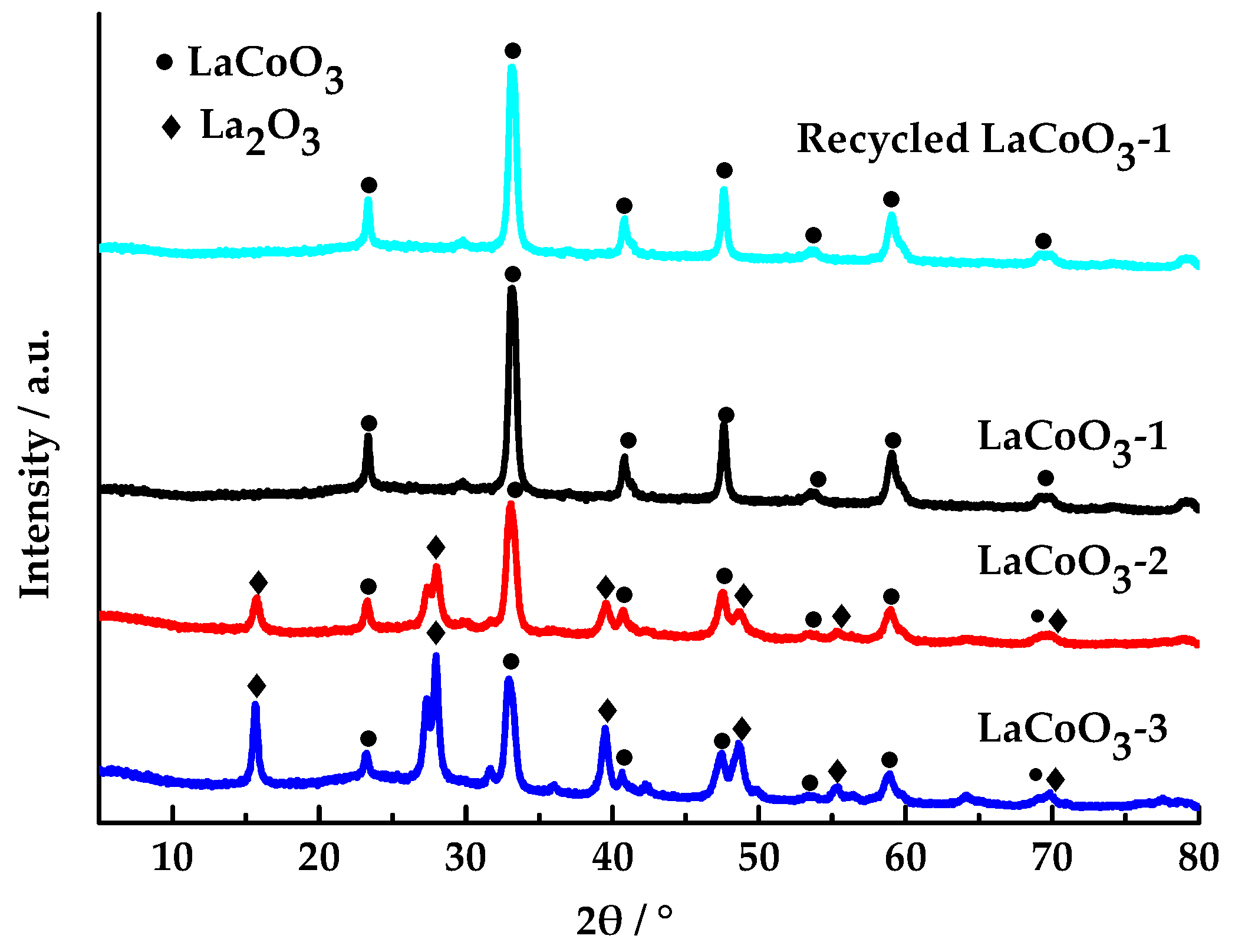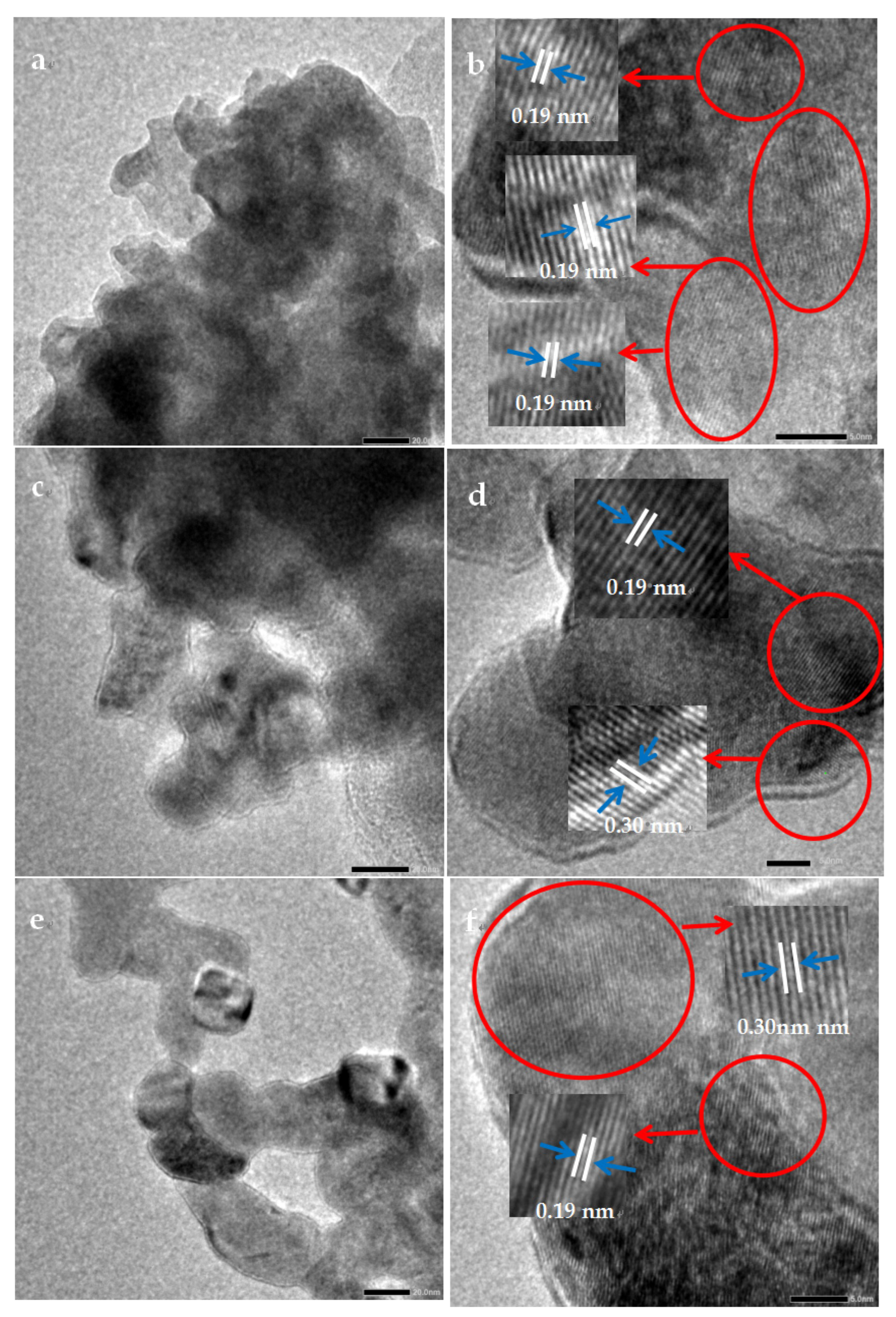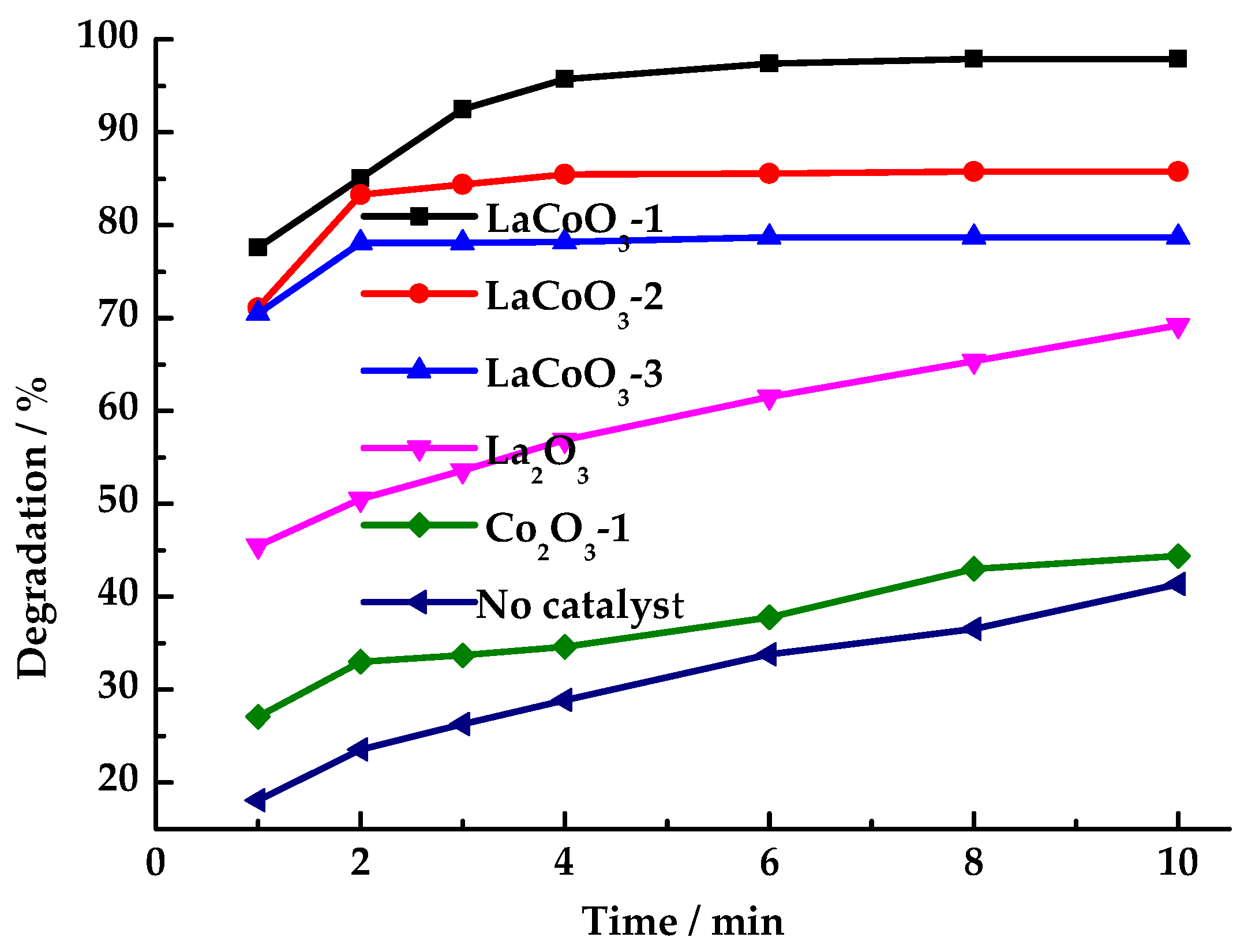Preparation of Perovskite-Type LaCoO3 and Its Catalytic Degradation of Formaldehyde in Wastewater
Abstract
1. Introduction
2. Materials and Methods
2.1. Materials
2.2. Methods
2.2.1. Preparation of Lanthanum Cobalt Oxide
2.2.2. Characterization of Lanthanum Cobalt Oxide
2.2.3. The Performance of HCHO Degradation
3. Results
3.1. TG Analysis
3.2. XRD Analysis
3.3. TEM Analysis
3.4. XPS Analysis
3.5. Investigation of Reaction Conditions for HCHO Degradation
3.5.1. Effects of Catalyst Types on HCHO Degradation
3.5.2. Effect of PMS Dosage on HCHO Degradation
3.5.3. Effect of HCHO Concentration on HCHO Degradation
3.5.4. Effect of pH Value on HCHO Degradation
3.5.5. Reusability and Stability of the Perovskite LaCoO3-1
4. Discussion
5. Conclusions
Author Contributions
Funding
Institutional Review Board Statement
Informed Consent Statement
Data Availability Statement
Conflicts of Interest
References
- Ding, N.; Li, Z.; Hao, Y.; Yang, X. A new amine moiety-based near-infrared fluorescence probe for detection of formaldehyde in real food samples and mice. Food Chem. 2022, 384, 132426. [Google Scholar] [CrossRef]
- Xu, Q.; Sun, H.; Ren, M.; Kong, F. A novel cellulose-based fluorescent probe for the quantitative detection of HCHO in real food samples and living cells. Ind. Crops Prod. 2023, 204, 117406. [Google Scholar] [CrossRef]
- Yamada, M.; Funaki, S.; Miki, S. Formaldehyde interacts with RNA rather than DNA: Accumulation of formaldehyde by the RNA-inorganic hybrid material. Int. J. Biol. Macromol. 2019, 122, 168–173. [Google Scholar] [CrossRef] [PubMed]
- Tong, Z.; Han, C.; Luo, W.; Wang, X.; Li, H.; Luo, H.; Zhou, J.; Qi, J.; He, R. Accumulated hippocampal formaldehyde induces age-dependent memory decline. Age 2013, 35, 583–596. [Google Scholar] [CrossRef]
- Suresh, S.; Kante, K.; Fini, E.H.; Bandosz, T.J. Combination of alkalinity and porosity enhances formaldehyde adsorption on pig manure -derived composite adsorbents. Micropor. Mesopor. Mat. 2019, 286, 155. [Google Scholar] [CrossRef]
- Yang, X.; Zhao, H.; Qu, Z.; He, M.; Tang, Z.; Lai, S.; Wang, Z. The effect of oxygen-containing functional groups on formaldehyde adsorption in solution on carbon surface: A density functional theory study. J. Environ. Chem. Eng. 2021, 9, 105987. [Google Scholar] [CrossRef]
- Yang, T.; Liu, Y.; Xia, G.; Zhu, X.; Zhao, Y. Degradation of formaldehyde and methylene blue using wood-templated biomimetic TiO2. J. Clean. Prod. 2021, 329, 129726. [Google Scholar] [CrossRef]
- Dai, M.; Li, F.; Zhang, J.; Shi, Q.; Wu, Y.; Kong, Q. Treatment of formaldehyde-containing wastewater and power generation by constructed wetland–microbial fuel cells enhanced by formaldehyde-degrading bacteria. J. Water Process Eng. 2024, 59, 104984. [Google Scholar] [CrossRef]
- Nisa, T.; Khokhar, W.A.; Imran, U.; Khokhar, S.A.; Soomro, N. Electrochemical treatment of wastewater containing urea-formaldehyde and melamine-formaldehyde. Chemosphere 2023, 338, 139587. [Google Scholar] [CrossRef] [PubMed]
- Bello, M.M.; Raman, A.A.; Asghar, A. A Review on Approaches for Addressing the Limitations of Fenton Oxidation for Recalcitrant Wastewater Treatment. Process Saf. Environ. Prot. 2019, 126, 119–140. [Google Scholar] [CrossRef]
- Ma, Q.; Hao, Y.; Xue, Y.; Niu, Y.; Chang, X. Removal of Formaldehyde from Aqueous Solution by Hydrogen Peroxide. J. Water Chem. Technol. 2022, 44, 297–303. [Google Scholar] [CrossRef]
- Mutia, A.S.; Ariyanto, T.; Prasetyo, I. Ciprofloxacin Removal from Simulated Wastewater Through a Combined Process of Adsorption and Oxidation Processes Using Fe/C Adsorbent. Water Air Soil Pollut. 2022, 233, 146. [Google Scholar] [CrossRef]
- Isinkaralar, K.; Gullu, G.; Turkyilmaz, A. Experimental study of formaldehyde and BTEX adsorption onto activated carbon from lignocellulosic biomass. Biomass Convers. Bior. 2023, 13, 4279–4289. [Google Scholar] [CrossRef]
- Henda, M.B.; Sadon, S.H.; Abdelmalek, Z.; Li, Z.; Le, Q.H. Removal of formaldehyde pollutant from petroleum industry wastewaters by polymers: A molecular dynamics simulation. Eng. Anal. Bound. Elem. 2023, 151, 400–405. [Google Scholar] [CrossRef]
- Vakylabad, A.B. Treatment of highly concentrated formaldehyde effluent using adsorption and ultrasonic dissociation on mesoporous copper iodide (CuI) nano-powder. J. Environ. Manag. 2021, 285, 112085. [Google Scholar] [CrossRef] [PubMed]
- Si, Z.; Song, X.; Wang, Y.; Cao, X.; Zhao, Y.; Ge, X.; Wang, Y. Assessment and Optimization of Formaldehyde Removal Using Tidal Flow Constructed Wetlands. Pol. J. Environ. Stud. 2021, 30, 987–992. [Google Scholar] [CrossRef]
- Chao, L.; Xiao, F.C.; Qin, Q.Z.; Chen, Y.Z.; Zai, X.L.; Jian, R.N.; Zhuang, H.; Qian, X.; Zhan, W.T.; Wei, T.M. Novel porous perovskite composite CeO2@LaMnO3/3 DOM SiO2 as an effective catalyst for activation of PMS toward oxidation of urotropine. Adv. Powder Technol. 2022, 33, 103802. [Google Scholar] [CrossRef]
- Isac-Gutul, T.; Tutovan, E.; Nika, D.L. Photo-Degradation of Dexamethasone through Radical-Based Advanced Oxidation Processes Using UV/H2O2 and Fe2+/UV/H2O2 Systems. Phys. Solid State 2025, 67, 292–301. [Google Scholar] [CrossRef]
- Santana, R.M.R.; Napoleao, D.C.; Dos Santos Júnior, S.G. Photo-Fenton process under sunlight irradiation for textile wastewater degradation: Monitoring of residual hydrogen peroxide by spectrophotometric method and modeling artificial neural network models to predict treatment. Chem. Pap. 2021, 75, 2305–2316. [Google Scholar] [CrossRef]
- Li, Y. Construction of WO3–visible light–H2O2 advanced oxidation system for degradation of organic pollutant. J. Mater. Sci. Mater. Electron. 2024, 35, 2070. [Google Scholar] [CrossRef]
- Wang, L.L.; Lan, X.; Peng, W.Y.; Wang, Z.H. Uncertainty and misinterpretation over identification, quantification and transformation of reactive species generated in catalytic oxidation processes: A review. J. Hazard Mater. 2021, 408, 124436. [Google Scholar] [CrossRef]
- Fama, Y.; Imae, T. Catalytic oxidation of formaldehyde in water by calcium phosphate-based Pt composites. RSC Adv. 2015, 5, 15944. [Google Scholar] [CrossRef]
- Zoh, K.-D.; Stenstrom, M.K. Fenton oxidation of hexahydro-1, 3, 5-trinitro-1, 3, 5-triazine (RDX) and octahydro-1, 3, 5, 7-tetrani-tro-1, 3, 5, 7-tetrazocine (HMX). Water Res. 2002, 36, 1331–1341. [Google Scholar]
- Chai, G.; Xi, H.; Qian, Y. Performance optimization and mechanism of HMX degradation by Fenton oxidation method. J Iran Chem. Soc. 2025, 22, 1009–1018. [Google Scholar] [CrossRef]
- Jiang, C.; Xing, B.; Yang, L. Fe–N co-doped carbon derived from one-step pyrolysis modified chitosan for activating H2O2 to degrade organic wastewater. J. Mater. Sci. 2024, 59, 9491–9501. [Google Scholar] [CrossRef]
- Ma, Q.; Shi, S.; Yang, F.; Zhang, X. Removal of formaldehyde in water with low concentration of hydrogen peroxide catalyzed by lanthanum-silicon oxide composite. Desalin. Water Treat. 2023, 300, 101–106. [Google Scholar] [CrossRef]
- Imohiosen, F.A.; Ofudje, E.A.; Al-Ahmary, K.M. Pharmaceutical effluent degradation using hydrogen peroxide-supported zerovalent iron nanoparticles catalyst. Sci. Rep. 2024, 14, 23957. [Google Scholar] [CrossRef]
- Xiong, Y.; Zhou, T.; Bao, J. Degradation mechanism of Bisphenol S via hydrogen peroxide/persulfate activated by sulfidated nanoscale zero valent iron. Environ. Sci. Pollut. Res. 2023, 30, 83545–83557. [Google Scholar] [CrossRef]
- Khan, A.; Yasin, S.; Mahmood, H. Mono-ethanolamine breakdown by UV/hydrogen peroxide via MEA photolysis: Kinetics, energy rate/order and degradation efficiency for mono-ethanolamine wastewater treatment. Braz. J. Chem. Eng. 2025, 42, 1079–1090. [Google Scholar] [CrossRef]
- Yu, C.; Liu, S.; Hu, W. Preparation of ferric hydroxide chelated glass fiber modified with dopamine chemistry for effective degradation of organic dyes by heterogeneous Fenton method. Res. Chem. Intermediat. 2025, 51, 2089–2104. [Google Scholar] [CrossRef]
- Athikaphan, P.; Wongsanga, K.; Klanghiran, S. Degradation of formaldehyde by photo-Fenton process over n-ZVI/TiO2 catalyst. Environ. Sci. Pollut. Res. 2023, 30, 90397–90409. [Google Scholar] [CrossRef]
- Bi, F.; Zhou, B.; Li, R. Synthesis of novel ZnO/NiFe2O4 heterostructures photocatalysts for photocatalytic and photo-Fenton removal of dyes. J. Mater. Sci. Mater. Electron. 2025, 36, 78. [Google Scholar] [CrossRef]
- Oh, W.D.; Dong, Z.; Ronn, G.; Lim, T.T. Surface-active bismuth ferrite as superior peroxymonosulfate activator for aqueous sulfamethoxazole removal: Performance, mechanism and quantification of sulfate radical. J. Hazard Mater. 2017, 325, 71–81. [Google Scholar] [CrossRef]
- Nie, Y.; Zhou, H.; Tian, S.; Tian, X.; Yang, C.; Li, Y.; Tian, Y. Anionic ligands driven efficient ofloxacin degradation over LaMnO3 suspended particles in water due to the enhanced peroxymonosulfate activation. Chem. Eng. J. 2022, 427, 130998. [Google Scholar] [CrossRef]
- Sojic Merkulov, D.; Vlazan, P.; Poienar, M.; Bognar, S.; Ianasi, C.; Sfirloaga, P. Sustainable removal of 17α-ethynylestradiol from aqueous environment using rare earth doped lanthanum manganite nanomaterials. Catal. Today 2023, 424, 113746. [Google Scholar] [CrossRef]
- Pang, X.; Guo, Y.; Zhang, Y.; Xu, B.; Qi, F. LaCoO3 perovskite oxide activation of peroxymonosulfate for aqueous 2-phenyl-5-sulfobenzimidazole degradation: Effect of synthetic method and the reaction mechanism. Chem. Eng. J. 2016, 304, 897–907. [Google Scholar] [CrossRef]
- Jain, A.; Pal, S.L.; Jaiswal, Y.; Srivastava, S. Designing a feasible phenol destruction process using LaM1−xCuxO3 (M = Co, Cr, Fe) perovskites as heterogeneous Fenton-like catalysts. Arab. J. Sci. Eng. 2022, 47, 5777–5796. [Google Scholar] [CrossRef]
- Ma, Q.G.; Huo, P.C.; Wang, K.S.; Yuan, Y.; Bai, S.J.; Zhao, C.T.; Li, W.Z. Preparation of Perovskite-Type LaMnO3 and Its Catalytic Degradation of Formaldehyde in Wastewater. Molecules 2024, 29, 3822. [Google Scholar] [CrossRef]
- Scelfo, S.; Geobaldo, F.; Pirone, R.; Russo, N. Catalytic wet air oxidation of D-glucose by perovskite type oxides (Fe, Co, Mn) for the synthesis of value-added chemicals. Carbohyd. Res. 2022, 514, 108529. [Google Scholar] [CrossRef] [PubMed]
- Qi, Y.; Peng, H. One-pot synthesis of La2O3-decorated Mg-Al oxides nanosheets for solar-light driven photocatalytic activity. Colloids Surf. A 2020, 604, 125316. [Google Scholar] [CrossRef]
- Li, C.; Li, Z.; Chen, X.; Zhang, Q.; Zhang, C.; Yue, X.; Xing, Q.; Tian, Z.; Ma, W.; Qi, H. Three-dimensional ordered macroporous eria-lanthanum cobaltate composite as efficient catalyst to activate peroxymonosulfate for N,N-dimethylformamide degradation. J. Mater. Sci. 2022, 57, 16280–16300. [Google Scholar]
- Zhong, Z.; Pan, J.; Li, M.; Wang, J.; Jiang, S.; Lin, J.; Xiong, Z.; Xie, A.; Luo, S. Enhanced electrocatalytic performance of LaCo1−xMnxO3 perovskite catalyst for glycerol oxidation. MRS Commun. 2022, 12, 786–793. [Google Scholar] [CrossRef]
- Wu, Y.H.; Liu, H.; Li, G.Y.; Jin, L.J.; Ou, X.M.; Dong, L.H.; Jin, G.Z.; Li, B. Tuning composition on B sites of LaM0.5Mn0.5O3 (M = Cu Co, Fe, Ni, Cr) perovskite catalysts in NOx efficient reduction. Appl. Surf. Sci. 2020, 508, 145158. [Google Scholar] [CrossRef]
- Chen, F.; Yan, H.; Wang, J.; Wang, H.; Sun, Y.; Chen, X.; Lu, W.; Chen, W. High-efficient catalytic ozonation for degradation of nitrobenzene in water with Ce-doped LaCoO3 catalyst. J. Mater. Sci. 2024, 59, 3406–3420. [Google Scholar] [CrossRef]
- Chen, X.; Qiao, X.; Wang, D. Kinetics of oxidative decolorization and mineralization of Acid Orange 7 by dark and photoassisted Co 2+ -catalyzed peroxymonosulfate system. Chemosphere 2007, 67, 802–808. [Google Scholar] [CrossRef] [PubMed]
- Liu, J.; Zhao, Z.W.; Shao, P.H. Activation of peroxymonosulfate with magnetic Fe3O4 -MnO2 core-shell nanocomposites for 4-chlorophenol degradation. Chem. Eng. J. 2015, 262, 854–861. [Google Scholar] [CrossRef]
- Brillas, E.; Sires, I.; Oturan, M.A. Electro-Fenton process and related electrochemical technologies based on Fenton’s reaction chemistry. Chem. Rev. 2009, 109, 6570–6631. [Google Scholar] [CrossRef]
- Lin, K.Y.A.; Lin, T.Y. Degradation of Acid Azo Dyes Using Oxone Activated by Cobalt Titanate Perovskite. Water Air Soil Pollut. 2018, 229, 10. [Google Scholar] [CrossRef]
- Wei, Y.; Ni, L.; Li, M.; Zhao, J. Acid treated Sr-substituted LaCoO3 perovskite for toluene oxidation. Catal. Commun. 2021, 155, 106314. [Google Scholar] [CrossRef]
- Mohammadifard, Z.; Saboori, R.; Mirbagheri, N.S.; Sabbaghi, S. Heterogeneous photo-Fenton degradation of formaldehyde using MIL-100(Fe) under visible light irradiation. Environ. Pollut. 2019, 251, 783–791. [Google Scholar] [CrossRef]
- Moussavia, G.; Yazdanbakhshb, A.; Heidarizad, M. The removal of formaldehyde from concentrated synthetic wastewater using O3/MgO/H2O2 process integrated with the biological treatment. J. Hazard. Mater. 2009, 171, 907–913. [Google Scholar] [CrossRef] [PubMed]
- Guimarães, J.R.; Farah, C.R.T.; Maniero, M.G.; Fadini, P.S. Degradation of formaldehyde by advanced oxidation processes. J. Environ. Manag. 2012, 107, 96–101. [Google Scholar] [CrossRef]
- Tan, Y.; Yin, C.; Zheng, S.; Di, Y.; Sun, Z.; Li, C. Design and controllable preparation of Bi2MoO6/attapulgite photocatalyst for the removal of tetracycline and formaldehyde. Appl. Clay Sci. 2021, 215, 106319. [Google Scholar] [CrossRef]
- Haddad, F.A.; Moussavi, G.; Moradi, M. Advanced oxidation of formaldehyde in aqueous solution using thechemical-less UVC/VUV process: Kinetics and mechanism evaluation. J. Water Process Eng. 2019, 27, 120–125. [Google Scholar] [CrossRef]
- Talaiekhozani, M.; Salari, M.; Talaei, M.; Bagheri, M.; Eskandari, Z. Formaldehyde removal from wastewater and air by using UV, ferrate(VI) and UV/ferrate(VI). J. Environ. Manag. 2016, 184, 204–209. [Google Scholar] [CrossRef] [PubMed]
- Yuan, D.; Tian, L.; Gu, D.; Shen, X.; Zhu, L.; Wu, H.; Wang, B. Fast and efficient oxidation of formaldehyde in wastewater via the Solar Thermal Electrochemical Process tuned by thermo electrochemistry. J. Clean. Prod. 2017, 156, 310–316. [Google Scholar] [CrossRef]









| Catalyst | Degradation (%) | Oxidant | Temperature (℃) | Reaction Time (min) | Reference |
|---|---|---|---|---|---|
| MIL-100(Fe) | 93 | H2O2/visible 132 radiation (Xenon, 55 W) | Ambient temperature | 119 | [50] |
| MgO | 79 | H2O2/O3 | Ambient temperature | 120 | [51] |
| - | 91 | H2O2/UV | Ambient temperature | 210 | [52] |
| Bi2MoO6/attapulgite | 58 | 150 W visible light | Ambient temperature | 120 | [53] |
| - | 85 | Vacuum UV | Ambient temperature | 60 | [54] |
| - | 69 | ferrate (VI) | 25 | 35 | [55] |
| - | 17.5 | Solar Thermal Electrochemical | 25 | 60 | [56] |
Disclaimer/Publisher’s Note: The statements, opinions and data contained in all publications are solely those of the individual author(s) and contributor(s) and not of MDPI and/or the editor(s). MDPI and/or the editor(s) disclaim responsibility for any injury to people or property resulting from any ideas, methods, instructions or products referred to in the content. |
© 2025 by the authors. Licensee MDPI, Basel, Switzerland. This article is an open access article distributed under the terms and conditions of the Creative Commons Attribution (CC BY) license (https://creativecommons.org/licenses/by/4.0/).
Share and Cite
Ma, Q.; Gao, Q.; Li, S.; Li, T.; Fan, Z.; Mu, B.; Zhang, Y. Preparation of Perovskite-Type LaCoO3 and Its Catalytic Degradation of Formaldehyde in Wastewater. Toxics 2025, 13, 955. https://doi.org/10.3390/toxics13110955
Ma Q, Gao Q, Li S, Li T, Fan Z, Mu B, Zhang Y. Preparation of Perovskite-Type LaCoO3 and Its Catalytic Degradation of Formaldehyde in Wastewater. Toxics. 2025; 13(11):955. https://doi.org/10.3390/toxics13110955
Chicago/Turabian StyleMa, Qingguo, Qin Gao, Shancheng Li, Tianying Li, Zhiqian Fan, Binglong Mu, and Yike Zhang. 2025. "Preparation of Perovskite-Type LaCoO3 and Its Catalytic Degradation of Formaldehyde in Wastewater" Toxics 13, no. 11: 955. https://doi.org/10.3390/toxics13110955
APA StyleMa, Q., Gao, Q., Li, S., Li, T., Fan, Z., Mu, B., & Zhang, Y. (2025). Preparation of Perovskite-Type LaCoO3 and Its Catalytic Degradation of Formaldehyde in Wastewater. Toxics, 13(11), 955. https://doi.org/10.3390/toxics13110955






